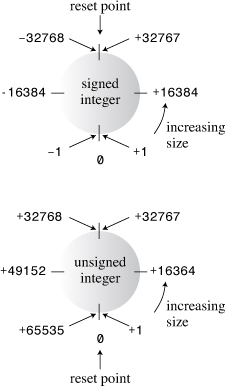Unsigned Types
Each of the four integer types you just learned about comes in an unsigned variety that can’t hold negative values. This has the advantage of increasing the largest value the variable can hold. For example, if short represents the range –32,768 to +32,767, the unsigned version can represent the range 0 to 65,535. Of course, you should use unsigned types only for quantities that are never negative, such as populations, bean counts, and happy face manifestations. To create unsigned versions of the basic integer types, you just use the keyword unsigned to modify the declarations:
unsigned short change; // unsigned short type
unsigned int rovert; // unsigned int type
unsigned quarterback; // also unsigned int
unsigned long gone; // unsigned long type
unsigned long long lang_lang; // unsigned long long type
Note that unsigned by itself is short for unsigned int.
Listing 3.2 illustrates the use of unsigned types. It also shows what might happen if your program tries to go beyond the limits for integer types. Finally, it gives you one last look at the preprocessor #define statement.
// exceed.cpp -- exceeding some integer limits
#include <iostream>
#define ZERO 0 // makes ZERO symbol for 0 value
#include <climits> // defines INT_MAX as largest int value
int main()
{
using namespace std;
short sam = SHRT_MAX; // initialize a variable to max value
unsigned short sue = sam;// okay if variable sam already defined
cout << "Sam has " << sam << " dollars and Sue has " << sue;
cout << " dollars deposited." << endl
<< "Add $1 to each account." << endl << "Now ";
sam = sam + 1;
sue = sue + 1;
cout << "Sam has " << sam << " dollars and Sue has " << sue;
cout << " dollars deposited.
Poor Sam!" << endl;
sam = ZERO;
sue = ZERO;
cout << "Sam has " << sam << " dollars and Sue has " << sue;
cout << " dollars deposited." << endl;
cout << "Take $1 from each account." << endl << "Now ";
sam = sam - 1;
sue = sue - 1;
cout << "Sam has " << sam << " dollars and Sue has " << sue;
cout << " dollars deposited." << endl << "Lucky Sue!" << endl;
return 0;
}
Here’s the output from the program in Listing 3.2:
Sam has 32767 dollars and Sue has 32767 dollars deposited.
Add $1 to each account.
Now Sam has -32768 dollars and Sue has 32768 dollars deposited.
Poor Sam!
Sam has 0 dollars and Sue has 0 dollars deposited.
Take $1 from each account.
Now Sam has -1 dollars and Sue has 65535 dollars deposited.
Lucky Sue!
The program sets a short variable (sam) and an unsigned short variable (sue) to the largest short value, which is 32,767 on our system. Then it adds 1 to each value. This causes no problems for sue because the new value is still much less than the maximum value for an unsigned integer. But sam goes from 32,767 to –32,768! Similarly, subtracting 1 from 0 creates no problems for sam, but it makes the unsigned variable sue go from 0 to 65,535. As you can see, these integers behave much like an odometer. If you go past the limit, the values just start over at the other end of the range (see Figure 3.1). C++ guarantees that unsigned types behave in this fashion. However, C++ doesn’t guarantee that signed integer types can exceed their limits (overflow and underflow) without complaint, but that is the most common behavior on current implementations.
Figure 3.1. Typical overflow behavior for integers.

